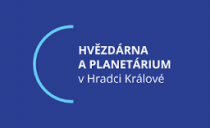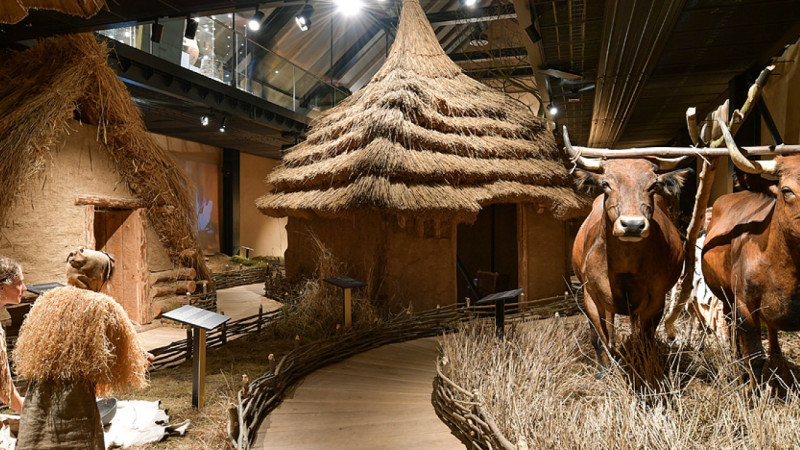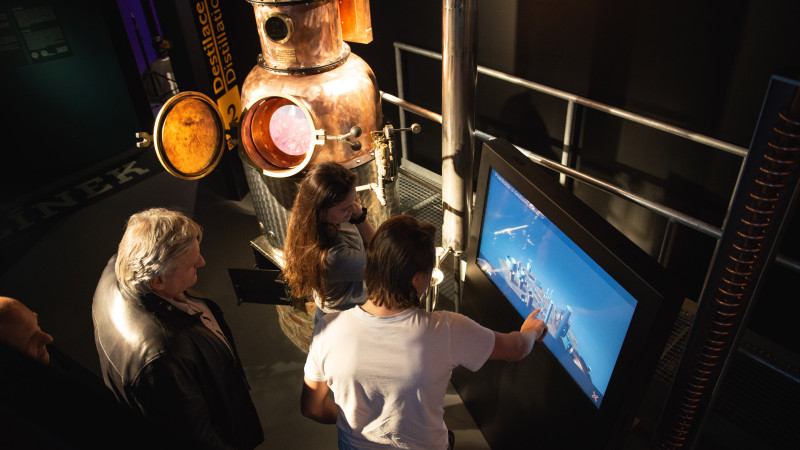
Digital Planetarium in Hradec Králové
The digital planetarium is entirely unique not only because of its new projection technologies, but also by its interactive expositions conveying uncommon experience
Unconventional and timeless design of the new digital planetarium building
The design of the new digital planetarium building respects the general character of the existing observatory facilities. The conspicuous building composed of a rotary ellipsoid set on a base shaped as a wide cuboid reminds of a landing spaceship. The ground floor contains an inclined hall with a capacity of 95 seats. On the top, a hemispheric projection surface is suspended with a diameter of 12 meters, inclined at 17°. On the ground floor and first floor, the centrally situated hall is surrounded by uncommon areas inspired by time-lapse pictures of the night sky and by the rings of Saturn.
Interactive exposition
The ground floor of the planetarium includes a spacious entrance area with the “Microworld – Macroworld” interactive exposition. Here the visitors can have a first-hand experience of interactive exhibits such as cloud chamber, plasma ball, earthquake plate or a model of the outer space. The first floor includes a circular gallery with the “Energy – Forms and Transformations” interactive exposition, where the visitors can obtain concise and clearly arranged information on some essential laws of physics. The exhibits that the visitors can actually use include a model of convection, an infra camera or a spectral lamp. On the terraces, the expositions are complemented by a meteo station and a robotic telescope demonstrating the opportunities of observation by means of a remotely controlled device.
The planetarium in Hradec Králové is the first facility in the Czech Republic with installed high contrast top level projectors
The technology is based on a purely digital system with several data projectors located around the hall just beneath the bottom edge of the projection vault, i.e. with no optical-mechanical projector that would occupy space in the middle of the hall. The technological solution for the planetarium in Hradec Králové comprises many aspects, however, the most important one is the creation of image in the planetarium. For this purpose, five VELVET projectors are used. These unique projectors have been developed and are manufactured by ZEISS in Jena, Germany, especially in order to project the night sky on a hemispheric surface. Besides other features, these projectors provide an extremely high static (native) contrast ratio achieved without using shutters, which would reduce image brightness. The quality of projected black allows for high quality and purely electronic integration of images from individual video channels while preserving a true representation of dark night sky. For each projector, image is created by a separate highly performing computer synchronized with other computers by a common server. The resulting image on the projection surface is thus composed of five sections interconnected with no perceptible transition. The projectors are equipped with special objectives designed for a sharp picture on the sphere. The projection system installed thus represents the starry sky with the maximum digitally attainable fidelity. The planetarium is also equipped with an auxiliary projection system based on a separate projector depicting data from other sources such as the robotic telescope on the southern terrace of the building. A prerequisite for such a projection is a practically seamless vault of the highest quality NanoSeam series by the U.S. company Spitz. Panels provided with powder coating and interconnected without overlaps with a submillimetre accuracy provide appropriate conditions for a large scale projection in the maximum possible quality. The sound system in a 5.1 configuration contains speakers located behind the projection vault and a high power subwoofer in the bottom part of the hall. The result of a combination of the comprehensive acoustic solution for the hall including the ceiling above the sound-permeable vault and the installed Crown & Yamaha system is a high quality sound with pronounced deep tones and a low noise level in the hall. The digital control is integrated into the planetarium’s control system. The whole-sky lighting is based on linear LED RGBW light sources mounted in the separation groove running along the entire bottom circular perimeter of the projection vault. Continuous control of colours and luminous power is also managed by the planetarium's control system.
Miroslav Krejčí, Director, Observatory and Planetarium in Hradec Králové
Thought the projection system allows for specialized simulations in astronomy, astrophysics, cosmology, astronautics and other fields of natural and technical sciences, an accurate and as true as possible representation of the night starry sky was and remains one of our main objectives. By implementing the Digital Planetarium project, our region perceives a shift in quality in genuine presentation of science and research. The project is intended for a wide public, as well as a large number of students and teachers visiting our observatory every year. Programmes focused on astronomy and associated natural sciences – based on understandable and interesting schemes – create a large space for promotion of results achieved in science, research, technology, development and innovation, and generate a logical area of activities supporting the interest by students in natural and technical sciences. Hopefully, at least some of them will decide for studying these difficult, but extremely interesting and useful fields.
Gallery

HVĚZDÁRNA A PLANETÁRIUM V HRADCI KRÁLOVÉ
The need for a new, larger and more technically advanced planetarium meeting not only the requirements of modern school teaching, but also those of contemporary illustrative and attractive programmes intended for the public, was leading, from the very beginning of the new millennium, to looking for opportunities for a significant upgrade of the existing equipment and of the insufficient spatial capacity. A promising opportunity did not appear before the second half of 2009, when the Ministry of Education, Youth and Sports announced a call for requests for support from the EU funds as part of the Research and Development for Innovation (R&DI) operational programme. In 2011, the project went though the evaluation of formal requirements and assessment of its overall quality. The “Digital Planetarium in Hradec Králové” project was evaluated as one of the best ones in the particular call and, already in the first round, it became one of eight projects proposed for implementation. The project implementation started on 1 December 2011. In the first half of 2012, documentation was created for the construction and, at the beginning of 2013, the construction of the new planetarium building started.



















